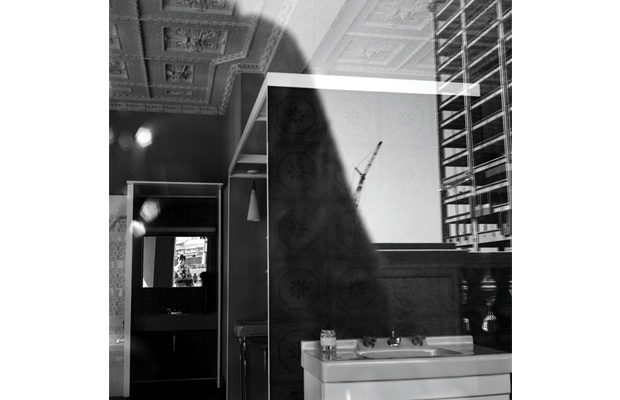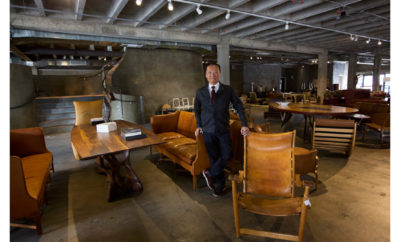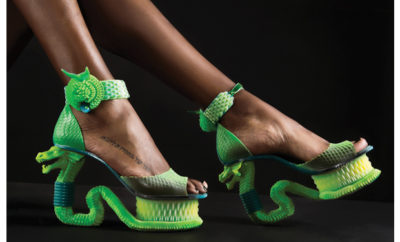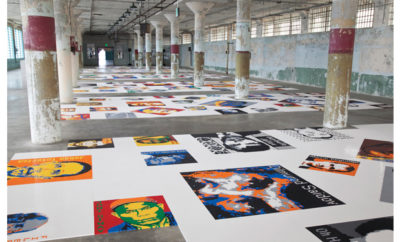
Feature
Grid Iron
The Architectural Photographs of Vivian Maier

Shot from outside an unidentified building, this photograph taken on June 27, 1964, is a double self- portrait of Vivian Maier (1926– 2009), revealing her image reflected in a mirror inside and her shadow cast on the plate glass store front outside. The image demonstrates her fascination with the way new construction, also reflected on the glass, was grafted onto the old city.
SINCE SHE DIDN’T DRIVE A CAR, the bicycle wheel signified independence for Vivian Maier during the years she lived in the suburbs of Chicago as a nanny and got around town on her bike. It also represented structural grace. You see this in what might be considered a self-portrait, Vivian’s Shadow on Bicycle Tire, where her lens studies the design of spokes threading out from the axle and attaching onto a metal hoop. The pattern of the spokes plays above their shadow (as well as above Maier’s own shadow) like an image from the constructivists Naum Gabo and Antoine Pevsner. Similarly, when she came upon a barrier fence battered down by a storm at the beach, she focused her camera on the splintered wood slats radiating around a hanger-like loop. From Maier’s viewpoint, the accidental structure looked like the air-filled configuration of a miniature architectural model.
The framework of things interested Maier deeply, and she seemed particularly inquisitive about the mass-less mass of modern architecture. This is evident in the many photographs of Chicago’s downtown she shot in the 1960s and early 1970s, when she would take the train into the city on her days off. The dynamic complexity must have relieved some of the restlessness she felt in the suburbs, where life was constricted and her observing eye was limited by the practical responsibilities of domestic work. Maier was new to he city; she had come from New York in 1956 when she was thirty years old. Like her mother and her grandmother before her, she did household work to earn a living. As she put it, she was sometimes a difficult person, private, closed off to strangers. When she went downtown, she suddenly merged into the powerful and constantly moving vitality of the city with its architecture in transition. The force of traffic, el trains, backhoes, jackhammers, and wrecking balls could be unbalancing, but shielded by the Rolleiflex strapped around her neck—actually looking down into its viewfinder—Maier was able to slow things down so the chaos was tolerable. She instinctively used the grid of the physical city, the angles of the streets, sidewalks, and massive buildings, old and new, to affix her compositions in space.

In this c. 1967–1968 photo Maier focused her camera on the splintered wood slats of a battered beach barrier fence radiating around a hanger-like loop of wire.
In the same way that some artists have a genius for rendering figures in the off-kilter but truthful midway of movement, Maier repeatedly documented the transitory quality of the city as she found it. The Wrigley Building, Tribune Tower, the original Stone Container Building, the Old Water Tower, the Michigan Avenue Bridge, the sidewalks between Marshall Field’s and the elaborately ornamented curved entrance to the Car- son’s Building, the Art Institute and Grant Park behind it, the movie palaces—State-Lake, Chicago, Woods, United Artists, Clark—these were her touchstones, and they delineated a province she shared with sailors on leave, women with scarves tied under their chins or wearing corsages on fur coats, men in straw hats, men in trench coats, many of them impassive faces that had survived the years of depression and war.

Maier documented the architectural transitions of Chicago, including the Wrigley Building (photographed late 1960s)
From her contact sheets, one can infer a method of working as she moved photographically through sometimes large and random blocks of space, documenting Chicagoans in their architectural domain. Shooting what she saw as she roamed, she often caught the way the design and mass of Chicago’s eclectic buildings were echoed by the shapes and configurations of the city’s inhabitants. An elderly woman’s egg- or dome- shaped hat, for instance, lines up humorously against the backdrop of the similarly shaped Tribune Tower and Wrigley’s clock tower.

A signature composition is Maier’s 1960 view of the intersection of Washington and South Wells Streets, anchored by the el station.
Some of the sites that interested her, such as the city’s dark viaducts and building canyons, presented technical challenges for her Rolleiflex, but given the right lighting, a bright morning sky or just after sunset when streetlamps add a glow of illumination, she was able to manage. In one of her signature compositions, she chose an intersection at Washington and South Wells Street anchored by the el station. From her vantage point, facing a corner parking garage—a boxy, brick, birdcage building typical of the pragmatic New Bauhaus—she structured her composition with the eye of an engineer. Zeroing in on the physics of overlap- ping architectural structures, she showed how the stairs to the el, the fretwork of the railing, and the metal bracing of the platform formed a series of vectors, while the right angle of the garage, the sidewalk, and the street lines of the crosswalk formed an alternative group of radiating lines. Maier analyzed the intricate solid geometry, the design of a city corner, and then pounced at the moment when four pedestrians reinforced the structure, lining up imperfectly in the luminescent slush on the street.

Taken in 1971, this view down State Street shows the Chicago Theater on the right and Marina City in the distance.
Over the years, Maier seemed to take a proprietary interest in the development of downtown spaces and she made it a habit to photograph the new skyscrapers, sometimes surrounded by cranes and sidewalk sheds, as they went up. Her images of the Chase Tower, the Brunswick Building, the Sears Tower, and the John Han- cock Center look something like personal souvenirs and demonstrate the difficulties of finding a vantage point and dealing with the physical limitations of her camera and its fixed lens plane and parallel plane. Unless the film plane can be kept parallel with the face of the building the sides of the building (any vertical lines) will converge as the building rises above the cam- era. The cereal-box shaped Prudential Building, forty-one stories high and representing the most modern technologies of its time, was new when Maier arrived in Chicago. In a playful photograph, several years later, she caught its limestone and glass facade low of center in her viewfinder while shooting from behind the tail of one of the the Art Institute’s lions.
During the 1960s the clean lines of new construction contrasted starkly with those of the old neoclassical and Beaux Arts buildings. After years of neglect, many of the landmark structures were covered with soot and had damaged masonry. Just as Maier documented the stoic and walled-off faces she noticed on the streets, she captured the architectural decay, destruction, and dismantling, an essential component of a modern city. Her photograph of the old Federal Building in the early stages of demolition is a study of a building’s anatomy. With Ludwig Mies van der Rohe’s new Dirksen Federal Building in the background, she took a long steady look where the edifice was skinned away, exposing opened up chambers that looked like a honeycomb.

Shot on June 27, 1964, this compelling composition shows the then Stone Container (now London Guarantee) Building, Marina City, and the Sun-Times Building (demolished in 2005).
Maier took many photographs at two of Chicago’s most important 1960s building projects— the Daley Center and Marina City. The design of the Daley Center (originally the Civic Center) was intended as an architectural homage to Mies van der Rohe and his International style that had so deeply influenced his adopted city. Simultaneously, city planners hoped to configure a European-style square by creating a large and open space north of the building site. The concept caught Maier’s fancy and she shot a whole roll of film, sometime around 1970, looking at a matrix of city experience charted on coordinates of the plaza. In one corner she caught two hard-nosed attorneys exchanging views about a dispute spilling over from the courtroom; in another, pedestrians approaching a sidewalk shed in an urban parade. Maier then angled her camera back to photograph the monumental Picasso sculpture and the unfinished construction of an adjacent building. When she stepped even farther away, she caught a group of office workers and tourists playing a game with coins, rolling them across the granite tiles, bracketed by the heroic glass base of the Daley Center. Her photograph highlights the prismatic quality of the building, transparent enough to see right through to the long, low Greyhound sign on the other side.
The construction of Marina City with its two sixty-story apartment towers—corncob towers, as Chicagoans refer to them—signaled an audacious breakthrough in architectural imagination. Solid but spatially fluid, the cylindrical towers were a corporeal reminder of the laws and language of three-dimensional geometry. Like the bicycle wheel, the structure was perfect, kinetic, and complex. When you look at the photographs Maier took during different stages of construction and from various vantage points, you can sense the impatience she must have felt, navigating the multiple levels of the city with its unwieldy bridges and buildings. The towers were pure anomaly: built from concrete but organically shaped, vertically masculine but cerebral, wind resistant but serrated like leaves, mysterious as primeval standing stones while displaying brightly painted automobiles on cantilevering garage floors. One particularly compelling composition shows what was then the Stone Container Building, the Marina City towers, and the Sun-Times Building standing in a row like stepping stones. The image gets at the growing pains of proportionality, an awkwardly beautiful moment in Chicago’s metamorphosis. While there was a sense of loneliness and isolation settling on the surface of the buildings that day—something the photographer could contemplate knowingly—the photographic lens showed Marina City bathed in a kind of smoky light that enhanced its abstract qualities. On the street, pedestrians, cars, a trailer, a trashcan, and a mailbox appeared becalmed and miniature in a space that they shared with a cluster of the city’s monumental and sculptural structures.












